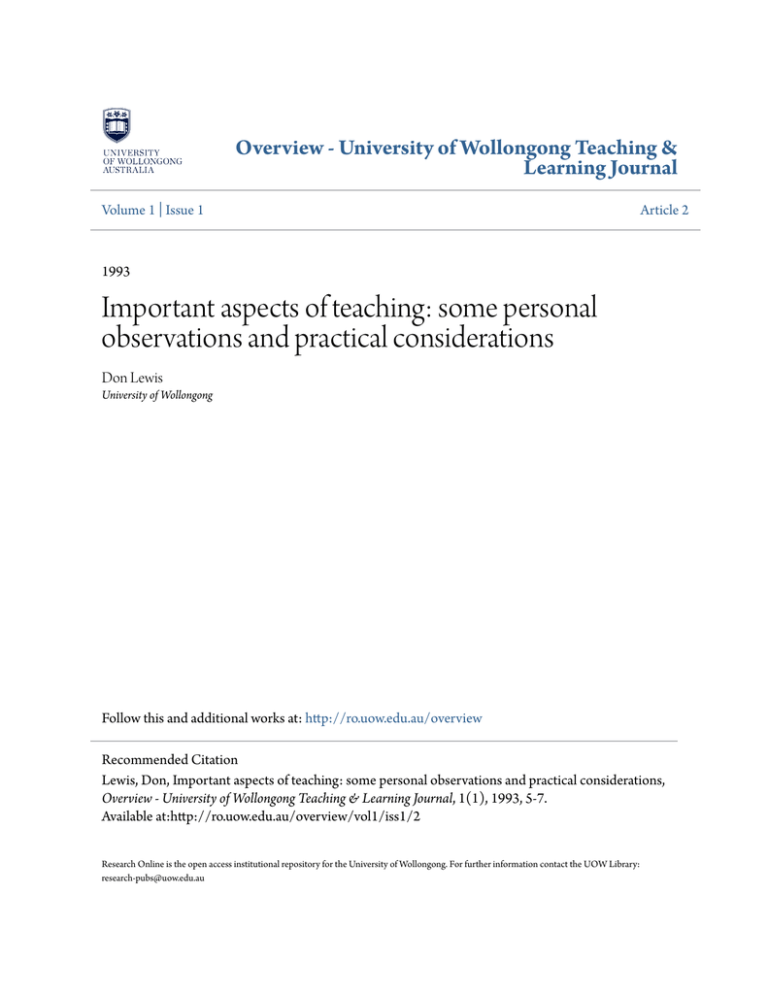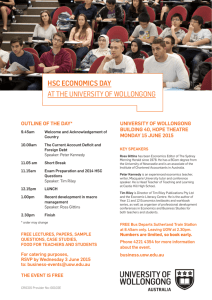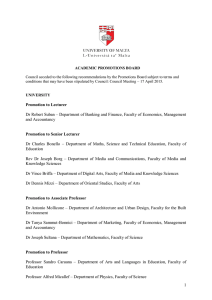Important aspects of teaching: some personal
advertisement

Overview - University of Wollongong Teaching & Learning Journal Volume 1 | Issue 1 Article 2 1993 Important aspects of teaching: some personal observations and practical considerations Don Lewis University of Wollongong Follow this and additional works at: http://ro.uow.edu.au/overview Recommended Citation Lewis, Don, Important aspects of teaching: some personal observations and practical considerations, Overview - University of Wollongong Teaching & Learning Journal, 1(1), 1993, 5-7. Available at:http://ro.uow.edu.au/overview/vol1/iss1/2 Research Online is the open access institutional repository for the University of Wollongong. For further information contact the UOW Library: research-pubs@uow.edu.au Important aspects of teaching: some personal observations and practical considerations Abstract What are the most important considerations in my undergraduate teaching? I have attempted to answer this question in two parts. In the first part I discuss some ideas and procedures that I have found useful. In the second part I address the specific issues of the relationship between good teaching and quality research. This journal article is available in Overview - University of Wollongong Teaching & Learning Journal: http://ro.uow.edu.au/overview/ vol1/iss1/2 The author, Profissor of Economics and a recipient of the Vice-Chancellor's Award for Excellence in Teaching, outlines his approach to improving student learning, He gives practical suggestiom on how to avoid concentrating solely on content, how to motivate students and how to make lectures more interesting, While many lecturers feel that teaching and research are incompatible and that it is difficult to maintain a high standard in both, Professor Lewis explaim why he fiels they complement each other, and how he has reconciled the perceived conflict. Important aspects of teaching: some personal obselVations and practical considerations by Don Lewis What are the most important considerations in my undergraduate teaching? I have attempted to answer this question in two parts. In the first part I discuss some ideas and procedures that I have found useful. In the second part I address the specific issues of the relationship between good teaching and quality research. General Considerations For me the first step is to articulate carefully the goals of the subject. I give a written statement to students which indicates the knowledge I hope the student will acquire and the skills which will, I hope, be enhanced. The knowledge and skills may be discipline or subject specific ("Develop an understanding of human capital theory") or general ("Improve the student's ability to make short oral presentations"). It is important that these goals are fully taken into account when making up the reading list and determining methods of assessment. For example, it would be inconsistent to specifY the importance of developing writing skills and then put a low weighting on the essay component of the assessment. The determination of the reading material is next. I try to make sure that the average student will be able to comprehend most of the items on the reading list. The more sophisticated textbooks and classic journal articles are generally avoided. Most students become disheartened if they are unable to cope with the reading material. What is important is not the level of sophistication of the material per se, but the amount of understanding the student acquires as a result of reading. They are more inclined to read further if they understand what they have already completed. I also avoid long reading lists in which there is a substantial amount of duplication. Listing five or six textbooks which are very dose substitutes for each other only confuses the student. It is better to choose one and expect students to work through it carefully. Listing all the important articles on a particular topic is not very helpful unless you expect students to read them all or you clearly label those to be read. Do not try to impress your colleagues by the length of your reading lists. I prefer July 1993 0 to keep the reading list short and expect students to read and comprehend all of the reading. While thinking about the goals of the subject and formulating the reading I am concerned about motivating the students. In general they will not come into the subject with an insatiable desire to learn. They have to be convinced that the subject is important and relevant to them. This is especially important in subjects which are mandatory. In the first lecture the goals of the" subject have to be sold to the students and then they need to be convinced that the reading list and the lectures will contribute to the attainment of these goals. Motivational considerations should also be at the forefront in preparing for each and every lecture. Why is a particular lecture important? Why is a particular theory or empirical analysis important? Why should the student be interested? It is absolutely essential that the lecturer is first convinced of the relevance and importance of the subject and material. Unless the lecturer is enthusiastic it is very unlikely that the student will be motivated to learn. They may go through the motions and put in enough work to pass the subject, but they will be uninspired and quickly forget the material. In my view many lecturers spend too much time preparing the content of their lectures and too little time thinking about their method of presentation. As a rough rule of thumb I spend 50 per cent of my preparation time on content and 50 per cent on presentation. The most common error with respect to content is trying to cover too much material. Students cannot absorb the amount of material that is often read to them in lectures. Transparencies prepared prior to the lecture often contain too much material, or diagrams which are too complex to be absorbed. By cutting down on the amount of material the lecturer can spend more time on motivation and be more careful and systematic when explaining an idea, theory or piece of empirical evidence. Students should come away from a lecture with a sense of accomplishment (they know what they have learned and why it is important). They should not come away feeling lost and overwhelmed. Attention to detail is very important when considering the method of presentation. Two examples will suffice. As soon as I know that I will be teaching a particular subject I begin the administrative manoeuvring necessary to ensure that the classroom will be the best possible. Is it the right size? Can the tables be arranged to facilitate discussion if required? Are the acoustics good? Will you and the students be comfortable? If you wait until the first lecture to see what room you have been assigned, it will probably be too late to change from an undesirable room. Attention to detail is also important when preparing 6 Overview transparencies and other visual aids. They can be very effective but too often are too small to be seen from the back of the room. When in doubt, I actually go into a vacant classroom, put up the transparency, and then make sure I can read it from the back of the room. Mter developing an idea I often use numerical examples to illustrate and reinforce the concept. The examples must be carefully chosen to illustrate the idea as simply as possible. The arithmetic has to be done in advance to make sure the solutions are simple and meaningful. Too often examples are chosen which complicate rather than highlight essential points. If at all possible, I avoid trying to spontaneously develop an example in class. Nothing will turn students off more than watching a lecturer trying to find the error in his or her calculations or trying to explain nonsensical results. Consideration of the pace of the lecture is also important. Firstly, I never write out lectures to be read in class. Students generally find listening to someone read their material very boring, in part because the delivery is too fast and the amount of material presented is too much to be fully absorbed. Instead I prepare notes and fully developed examples, diagrams, etc. The material needs to be presented in an orderly manner and carefully explained, but each sentence does not have to be grammatically perfect and students do not mind if you sometimes have to search for the best adjective, or pause to collect your ideas. Secondly, material often needs to be broken up. Long, theoretical sections of a lecture can be interrupted by examples or by giving the students an opportunity to ask questions or make comments. Relevant stories or personal anecdotes can break up long boring passages and can also be used to illustrate a principle. They are also more likely to be remembered. Finally, it is important that students sense that you genuinely care about them and their learning. Let them know that you want them to understand the material or develop new skills because you think it is important for them, not just because they are important to you or because you want them to jump through mental hoops. Assignments, essays and examinations should be portrayed as vehicles for relevant learning and development and not merely obstacles to be overcome on the way to a degree. Teaching and Research From a personal perspective a close link between teaching and research promotes good teaching and facilitates effective research. Sometimes teaching has led my research and in other instances research has led my teaching. Whichever the direction of causation, * I have tried to maximise the overlap between the subjects I teach and the topics and methodology of my research. The advantages of a close relations~ip between teaching and research are many and faIrly obvious. Firstly, much of the intellectual capital one accumulates can be applied to both. When reading for purposes of research I am always on the look out for articles that are well suited for students; when preparing for lectures I occasionally come across articles or ideas which are relevant to my research. Secondly, students benefit from having a lecturer who is at the forefront of knowledge and who is making original contributions to the subject. Such a person should be much more knowledgeable and aware of the limitations of the analysis. (One potential problem, however, is that the lecturer may give a narrow perspective of the subject area that is limited to his or her own research methodology or experiences). Thirdly, it is generally easier to be enthusiastic about teaching material that is directly relevant to one's research. This enthusiasm is also more likely to be contagious. Finally, presenting research material to students in a simple and understandable manner can often lead to insights into your own research. The potential problem is that knowledge of all the complexities and subtleties of one's research area may prevent one from getting across the fundamental ideas embodied in that research. The problems of teaching and conducting research in disparate areas are also fairly obvious. It is difficult and very time consuming to try to keep up with the literature ifyou are not an active researcher in the field. At the same time research is more difficult ifyou are not teaching in the area. You tend to be more isolated and inward looking in your research. Teaching forces you to read more widely than you might otherwise and students are an excellemsounding board for new ideas. Finally, it is easier to build up library resources ifyou are teaching and researching similar topics. (a) Teaching-led research refinements the two books were published by Harcourt Brace Jovanovich and have been adopted in many universities throughout Australia and New Zealand. By being allowed to teach the same subjects for more than a decade, my colleagues and I were able to integrate our teaching and research. The research was obviously fostered by the teaching skills and experience that we developed. Our teaching also benefited from our research. Concepts that we thought we fully understood required greater study whe~ .we attempted to explain them more formally. Crmcal comments by students and colleagues were also helpful. This process, no doubt, made us more aware of our own deficiencies and improved our teaching. (b) Research-led teaching For many years I have been teaching a third year subject for economics majors entitled "Applied Microeconomics". The subject was specifically designed to complement my research interests and each year we explore 4-5 topics such as the economics of education, the economics of health care, the economics of crime and women in the economy. These topics have been the focus of my research over the past fifteen years and many of my published articles are included in the reading list (there is no textbook). This means that nearly all of my research (other than the textbooks referred to above) can be related to the subject, either as components of the reading list or in the preparation of lectures. Teaching and conducting research in the same areas has greatly increased my research productivity and enhanced the quality of my teaching. In my experience teaching and research are fully complementary. Don Lewis is Proftssor ojEconomics at the University ofWollongong and was a recipient ofthe Vice-Chancellor's Awardfor Excellence in Teaching in 1991. Thispaper was originallypreparedfor theA VCC Symposium on the Quality of Teaching in Higher Education Imtitutiom, Canberra, December 1991. After teaching a first year subject in statistics and mathematics for students in business and economics for more than ten years, two colleagues and I decided to write two textbooks. This followed the gradual accumulation of lecture notes, worked examples, and pedagogical insights into what worked and what did not. The lecture notes, which were skeletal, were given flesh and detail and written up, printed on campus and sold to our students in lieu of a textbook. After three years and numerous useful comments from students, revisions, corrections and July 1993 1


